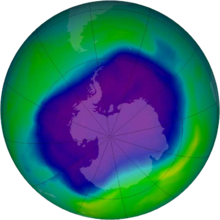
From Montreal Protocol to Paris Agreement
In 1987 Montreal Protocol was signed and 197 countries agreed to reduce the global production, consumption, and emissions of ozone-depleting substances (ODSs). According to scientists, there is evidence that the hole in the ozone layer over Antarctica is beginning to heal and it is expected to permanently close by 2050.
The Montreal Protocol is one of the most successful United Nations environmental agreements, and it is expected that two million cases of skin cancer will be prevented each year by 2030.
28 years after the Montreal Protocol was signed, 197 countries unanimously signed Paris Agreement. But this time, will the Paris Agreement be successful?
It has not been easy. In 2017, former U.S. President Donald Trump announced that the United States would withdraw from the Paris Climate Agreement, claiming that the agreement would undermine the U.S. economy, and put the U.S. “at a permanent disadvantage.”
Where did President Trump’s remark come from? The Paris agreement creates different sets of rules for each country, with developed countries assuming more responsibilities. Compared with developed countries, there should be no disadvantage for the United States. However, compared with China, maybe yes. Despite being the second-largest economy in the world, China is still considered a developing country based on the criteria of the World Bank and the United Nations. Therefore, China is assuming less responsibility than the U.S.
In addition, a few years ago, China was not cooperating, either. It believed that global warming, carbon tax, and reduction of carbon emissions were conspiracy theories, and it perceived that carbon reduction was an excuse for the United States to unite with other developed countries to restrict China’s development.
Only in recent years, China has undergone a change in its perception and has realized that emission reduction not only protects the environment but also represents new opportunities. Coal power has been the dominant source of energy in China, so to achieve net zero-emission, its priority is to replace coal with renewable energy. After several years of development, China’s wind power and solar power technology as well as installed capacity have all reached the world’s first place. Earlier this month, President Xi Jinping made an announcement at the United Nations General Assembly that China will step up support for other developing countries in developing green and low-carbon energy, and will not build new coal-fired power projects abroad.
Here in the U.S., after President Biden took office, he immediately brought the U.S. back to the Paris Agreement. Up till now, the two largest economies of the world are finally moving towards the same goal in this regard. China and the U.S. are the two largest emitters, accounting for 44% of total emissions of the world. If these two countries can achieve net-zero emission someday down the road, close to half of the world’s emissions will be gone. I am very optimistic that the two can achieve the goal in that climate issue means big opportunities. We are expecting to see the two countries compete down the road in developing clean energy and new technologies such as power storage, biodegradation, sustainable building materials, synthetic meats, etc.
The next few larger emitters (except Russia and India, accounting for 11-12% of total world emissions) like EU countries, Japan, Australia, and Canada have long been putting efforts on reducing carbon emission, encouraging circular economy as well as the development of net-zero cities and communities. A small EU country, Sweden, the first nation to announce a phase-out plan for ozone-depleting substances as early as 1988, was once again heading ahead in this movement. It set a good example for other countries to follow.
Giant petroleum companies such as BP, Shell, Chevron, and Exxon have been entering into renewable energy industry gradually. They have all pumped billions into clean energy projects, so are giant fossil fuel energy corporations. The fossil fuel industry will diminish, according to climate finance analysts, because of higher investment risks caused by competition from clean energies and tougher government policies on emission.
The world is heading in the right direction in reducing emissions. Now the question is if the countries are acting quick enough to prevent the global average temperature from rising 1.5 °C.
2 thoughts on “From Montreal Protocol to Paris Agreement”
Comments are closed.
Thanks for your post. What I want to comment on is that when evaluating a good on the net electronics store, look for a web page with full information on critical factors such as the level of privacy statement, basic safety details, payment guidelines, and other terms in addition to policies. Usually take time to look at help plus FAQ sections to get a far better idea of how the shop performs, what they are able to do for you, and ways in which you can maximize the features.
My coder is trying to convince me to move to .net from PHP. I have always disliked the idea because of the costs. But he’s tryiong none the less. I’ve been using WordPress on numerous websites for about a year and am worried about switching to another platform. I have heard good things about blogengine.net. Is there a way I can transfer all my wordpress content into it? Any kind of help would be greatly appreciated!